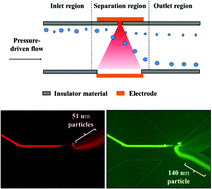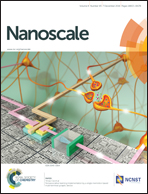Separation of nanoparticles by a nano-orifice based DC-dielectrophoresis method in a pressure-driven flow
Abstract
A novel DC-dielectrophoresis (DEP) method employing a pressure-driven flow for the continuous separation of micro/nano-particles is presented in this paper. To generate the DEP force, a small voltage difference is applied to produce a non-uniformity of the electric field across a microchannel via a larger orifice of several hundred microns on one side of the channel wall and a smaller orifice of several hundred nanometers on the opposite channel wall. The particles experience a DEP force when they move with the flow through the vicinity of the small orifice, where the strongest electrical field gradient exists. Experiments were conducted to demonstrate the separation of 1 μm and 3 μm polystyrene particles by size by adjusting the applied electrical potentials. In order to separate smaller nanoparticles, the electrical conductivity of the suspending solution is adjusted so that the polystyrene nanoparticles of a given size experience positive DEP while the polystyrene nanoparticles of another size experience negative DEP. Using this method, the separation of 51 nm and 140 nm nanoparticles and the separation of 140 nm and 500 nm nanoparticles were demonstrated. In comparison with the microfluidic DC-DEP methods reported in the literature which utilize hurdles or obstacles to induce the non-uniformity of an electric field, a pair of asymmetrical orifices on the channel side walls is used in this method to generate a strong electrical field gradient and has advantages such as capability of separating nanoparticles, and locally applied lower electrical voltages to minimize the Joule heating effect.


 Please wait while we load your content...
Please wait while we load your content...